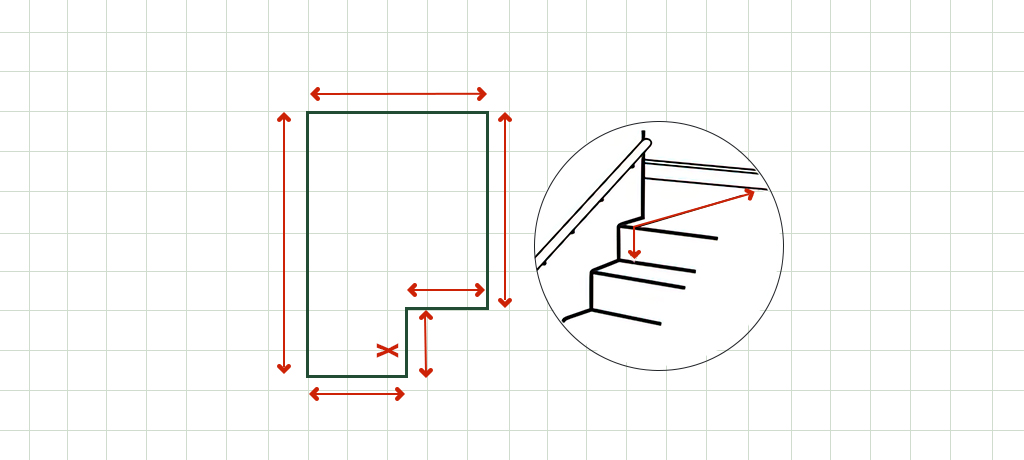It is important to decide how you should measure a room or other floor type for the carpet. Getting the right measurement is not at all discouraging by following some tips on carpet measurement. This carpet measuring guide will provide an idea about:
- How to Measure a Standard Room
- How to Measure Irregular Shaped Rooms
- How to Measure a Hall
- How to Measure a Landing
- How to Measure Stairs
Get the Right Measurements: How to Work on them
Though this is a carpet measurement guide, some sections seem to be applicable to measuring rooms for the vinyl flooring and other floor options. You may go through this guide with our carpet purchase guide to know the basics of measuring the flooring space.
So, you have already decided to purchase a new carpet for your home. One of the things you need to know is how much carpet you will exactly require. This will enable to get an estimation cost of buying carpet.
Under or overestimating required carpet area can prove pricey. You can find measurements which are calculated in square meters to avoid mistakes. It is suggested to take carpet measurement in the right way. If you want to take measurements yourself, how will you measure for a carpet? How do you measure the complicated areas such as your stairs, landing and hall?
In order to measure and record your room size, you require a tape measure, pencil, pen, ruler and a piece of paper.
How to Measuring Rooms of Standard Shape
If your room is square or rectangular, it is necessary to measure in a straightforward way. You need to measure the width and length of the room and then multiply these two measurements to know the size of your floor surface.
When calculating a room, make sure you consider built-in units, chimney breasts or any recesses as carpet fitter cuts the flooring to fit around them. Essentially, you need to measure the room as any of them are not there.
There are various carpets of different widths measuring 4 meters and 5 meters and they aim to lessen the number of joins needed. Make sure you know the exact measurements before deciding on the design and style of the carpet you like.

Example of Standard Room:
Calculate the length and width of the room by keeping in mind to measure alcoves, doorways and recesses.
How much extra should you add for carpet measurement?
You can add up 10 centimetres to the entire measurements of length and width. This additional amount enables for any deviations in the wall and the cutting when fitting carpet.
You need to be careful as many rooms are not perfect squares and allowing 10cm might not be sufficient. You may take two measurements for the length and two for the width and use the largest measurement.
Hopefully, this has provided valuable pointers on how you can measure a room for carpet.
How You will Measure Irregular Shaped Room
If your room is odd shape or has alcoves, chimney breast or recess, you need to keep them in mind for carpet measurement. How you measure unusual shaped room depends on whether you want any joins in the carpet.
Drafting a suitable plan for the room is a great way to begin with and ensures you do not miss wall areas. Measure the doorways, recesses and window bays.
To remain on the safe side, measure every wall in the room which includes the depth of alcoves. They come in handy if you have to join two or more carpet pieces together. You will get all the measurements you require with each wall measurement.

Example of an irregular-shaped room
Measure odd shaped rooms just like rectangular rooms but you have to take more measurements. Evaluate recesses, alcoves and doorways.
Now, you have valuable pointers for measuring irregular-shaped rooms.
How to Measure Halls and Unusual Halls
Hallways may be among the smallest areas of your home, but they usually have more intricate shapes and doorways. You will have to take care when measuring them as halls are available in different shapes and sizes and not straightforward to measure all the time.
For example, if you are having L-shaped hallway, you need to divide it into two rectangles. You may then calculate the size of each rectangle and add the two values together. This method will provide total area of the hall and need for a join in your carpet. To prevent a join, you will have to multiply longest length by the width but no join.
Example of an L-shaped hall

Calculate over the top step, into the doorways and recesses. Mark stairs position with a cross.
When you do not have T-shaped, L-shaped or inverted halls, measure a hallway like a standard room by recording the length and width and taking into account alcoves or recesses. Add 10 centimetres to the total measurements for length and width. This enables for any deviations in the wall and for the cutting when fitting the carpet.
After considering how to measure hallways; let us find out how to measure a landing and mid-landing.
How to Measure Landing
How to Measure a Standard Landing
When measuring a landing area for the carpet, it is essential your measurements include top step of the landing and the stairs. You include top step so the landing carpet will flow over top step and into stairs once it is fitted.
For measuring a standard room, you can outline a landing area plan and ensure to include all the areas including doorways and recesses.
Example of a main landing area

Calculate over the top step, into the doorways and recesses. Mark stairs position with a cross.
Stand at the top step and mark on your plan where landing meets stairs. Measure the length and width of this area and multiply the measurements to know how much carpet you require.
Use metric measurements, add 10 centimetres to the total measurements of length and width.
How to Measure a Mid-Landing
You need to measure a mid-landing as you would for normal landing area. The mid-landing carpet should fit over the top step in one piece and you need to measure mid-landing length and width as well as the width and height of the top step.
In other carpet measurement guide, add 10 centimetres to the entire length and width measurements.
The final part of this carpet measuring guide discusses about measuring stairs including winder stairs and bullnose steps.
Example of a mid-landing area

Half landing is in the shape of large square step and usually half way up the stairs where the stairs take a turn. If the stairs do not have one of these, then pay no heed to this step.
Find orange line to calculate the width for half landing.
Check blue line to work out the length of half landing with drop over step
How to measure stairs
How to measure carpet for stairs
Firstly, you need to double-check all the stairs so that they have the same width and then measure the riser and tread. This is the length which seems to be vertically up and over the step. Multiply this measurement by the number of stairs you have.
If some steps have different sizes, repeat the procedure for each one. You may then add the entire size of all the steps together.
Example of standard stairs

You do not have to measure stairs length ad write down these things
Number of stairs: staircase has 13 stairs, on average
Calculate tread and riser: It will be under 45 cm. (see Green line)
Check stair width: It will be between 76 cm * 93 cm. (see Red line)
This is all you require for staircase. If the staircase has half landing, bullnose or winders, just follow the relevant steps above and below.
You need to measure the height, width and depth of the stairs accurately. For the precise measurement of all stairs types, we suggest getting this done from our carpet specialists. This lessens any chance of paying for unnecessary wastage or not ordering sufficient carpet.
Measuring Winder Stairs
If you have a corner or winding staircase, you need to create a a note of different measurements for the winder section.
There are three winder steps to take into consideration. For each one, try to measure the length and the width at the widest part. This is important as pile direction goes over stair nose and at the right angle.
The widest part may be the edge, middle or back, based on how the stairs are fitted.
Example of winder stairs

Winders have the shape of wedge rectangle which appear like half landing and turn stairs through 90 degrees. Make a note of:
Winder 1
90 degrees over step * Width at the widest point
Winder 2
90 degrees over step * Width at the widest point
Winder 3
90 degrees over step * Width at the widest point
Measuring a Bullnose Step
A bullnose step is the curved and last step for the staircase. All stairs do not have a bullnose step but when you need to measure one, here is how you can do it. Start with length measurement of the last step with straight stairs.
For measuring the curve, you need to wrap tape measure around the entire curve step for confirming correct measurement.
This completes the final part of carpet measuring guide. For more advice on how to measure for carpet, feel free to contact our carpet fitters at M&M Carpets.
Example of a bullnose step

It is odd shaped step at the bottom of staircases and wider than normal step. It is round in shape on either one or both the sides. Take these necessary measurements:
See Red line for width around skirting
See Green line for step and riser of bull nose




